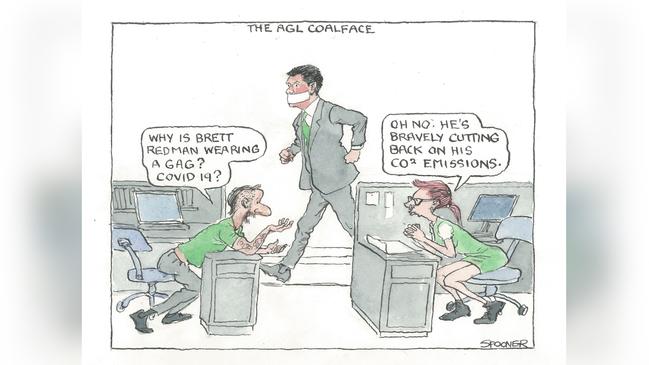Is AGL virtue signalling by linking exec pay to carbon cuts?


Inevitably the move will be tagged as virtue signalling. The company accounts for 18.7 per cent of top-50 company emissions and until it starts shutting coal-fired generation it will stay in the lead.
The naysayers will say the move says the right things without actually doing anything until coal-fired generators are cut.
The best way for AGL to show its commitment is to publish clear targets and details on policies in its remuneration report as part of the transparency promised in its climate action statement. Criticism of the plan to pay AGL executives for doing what they should be doing forgets that reducing carbon will now rank with total shareholder returns and improved returns on capital — which are now all part of the executives’ day job.
The new climate policy will split long-term incentives into three with a third for return on capital hurdles, a third on total shareholder return and a third on emissions reduction.
This will come in the form of efforts to diversify into renewables like wind power, new customer policies to direct payments to offset carbon emissions and actual carbon reductions.
Environmental approvals for its proposed Cribb Point gas import terminal in Victoria will start from Thursday.
The company is committed to net zero emissions by 2050 and plans to use its coal-fired generation stations to help pay for the transmission to new power sources. It is committed to closing the Liddell Power station in 2023 and Bayswater in 2035.
The new climate statement was well received by investors with First State welcoming the moves as part of a more rapid transformation into a low carbon future.
More investors are demanding so-called ESG action from companies, and customers are also preferring to buy energy from companies committed to a low emissions future.
AGL may be virtue signalling, but it is a response to market-led demands from both investors and consumers who will monitor progress. The climate policy will commit the company to be carbon net neutral by 2050 through a number of initiatives including offering customers the choice of carbon neutral gas and electricity.
This matches the commitment of all the states leaving Canberra as the main participant without a firm long-term commitment.
In his climate action statement, Redman said: “We believe that Australia’s energy future will be affordable and smart — delivered from renewable sources that are backed by flexible energy storage technologies which come together to power our homes, businesses and vehicles.
“We believe this will underpin the competitiveness of the Australian economy just as cheap fossil fuels did in the 20th century.”
AGL’s commitment includes carbon-neutral prices, helping to develop voluntary carbon markets, transitioning energy sources to renewables, investing in new sources of supply, and being transparent.
Super merger
Economies of scale and the ability to drive down costs are the key benefits to members from the First State-Vic Super merger, according to the combined $120bn fund’s new boss Deanne Stewart.
Outgoing Vic Super boss Michael Dundon said his members had already benefited from a 20 per cent cut in fees. Dundon will be part of the group’s executive committee looking at strategy.
The firm will be the second biggest behind AustralianSuper at around $180bn but both will be passed by the combined Sun Super and Q Super which will have $195bn under management should their proposed merger proceed.
The deal has taken some 18 months to put together but Stewart already has other irons in the fire with a proposed acquisition of WA Super which manages money for local governments in the state.
First State has tended to stick to its home turf with the mergers being for public servant funds as opposed to the talks between Media Super and Cbus which combines media and builders.
There are two views. Superannuation Minister Jane Hume argues membership diversification, like portfolio diversification, is good for the fund.
Others fundamentally disagree, saying funds should stick to their industry sector in part because funds like Media Super and Cbus both invest back into their industries..
APRA has encouraged fund mergers in an attempt to rid the industry of poor performing funds with high fees and is trying to get rid of laggards by naming and shaming. Scale is the perceived key of mergers, but cultural fit is the challenge.
The old industry groups are said to still control some funds with reports that Media Super’s proposed merger with AustralianSuper was stopped because the former’s print industry members were not keen on the deal.
First State’s Stewart said policy certainty was the key for the industry. She was commenting on the push by some backbenchers to delay the proposed increase in the super guarantee from 9.5 per cent to 12 per cent.
The contribution will increase to 10 to 12 per cent starting with an increase to 10 per cent in 2021.
The campaign against the increase says it will come at the expense of wages which is ironic when you consider when the system first started in 1991, the ACTU pushed for the introduction as a way to boost worker income.
One of the industry’s regrets is Canberra’s failure to come up with a bipartisan statement on the industry’s core purpose.
The preferred statement being simply to increase member retirement income.
Later this month Treasurer Josh Frydenberg will receive Mike Callaghan’s report on Retirement Incomes policy.
The report is aimed at being fact rather than policy based so Canberra can work from common ground to establish new policy.
The industry would obviously prefer if the contributions rate increased as proposed and funds are quick to note Ministers from Prime Minister Scott Morrison down have stressed the law as written mandates the increased contribution rate.
Blockchain on hold
The ASX has delayed the introduction of its new blockchain clearing and settling system for 12 months, pushing it back until April 2022.
COVID-19 and allowing more time for users to get their houses in order were cited as the major reasons for the delay.
The planned trials of the system have also been delayed until December to again give participants more time.
The move should also placate the naysayers like Computershare and Link who have consultants on the payroll to fight against the changes.
They argue the new system will increase the ASX’s control over many activities linked to share trading, including proxy voting and effectively replace the work done by the registry companies.
The ASX says it is simply replacing its 26-year-old CHESS system but the ACCC is watching with interest.
The ACCC’s landmark report on the Murray Darling water trading system was handed to Treasurer Josh Frydenberg on Tuesday. He has 28 days to consider the report before releasing it.
The report looks at the trading system to determine if it is working efficiently looking at among other issues the role of non-landholding traders in the market and their impact on prices and availability.

AGL’s boss Brett Redman will be the first top-50 company boss to have his pay linked in part to carbon reduction progress as the country’s biggest emitter attempts to fast-forward changes.